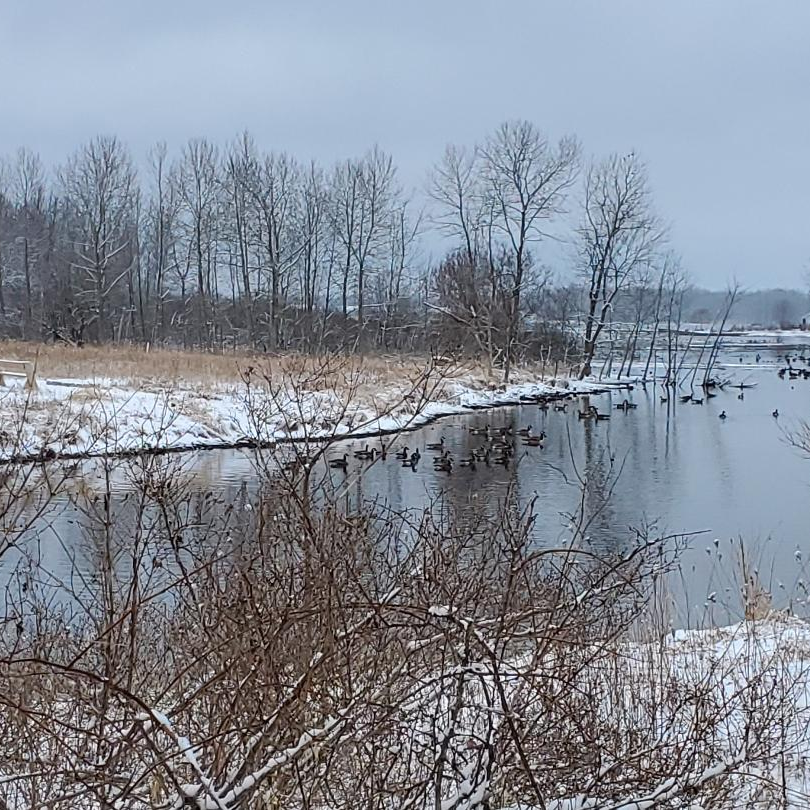By Coggin Heeringa, Interpretive Naturalist, Crossroads at Big Creek, Inc.
During the New Year’s Eve Hike to Crossroads’ Cove Estuary Preserve, we observed ice starting to form. During the December cold snap, the whole body of water was iced over, but we had some areas of open water during the holiday week. Seeing a skim of ice on the surface near the shore, one of our young visitors wanted to know if the water would freeze all the way to the bottom.
Turns out, this is a really important question. So, it will be the topic of our family programs this week at Crossroads. On Wednesday at 10:00 a.m., the Junior Nature Club, our program for pre-school-aged children and their adult companions, will explore ice … and what lives beneath the surface. The Discovery Outdoors Club, a family-friendly program (but adults are welcome), will meet at 2:00 p.m. on Saturday. Activities are appropriate for school-aged students, but we will have a “kiddy pool” so the whole family can participate. Weather-permitting, there will be an outdoor component to both programs.
But the ice question? It is highly unlikely that Big Creek or the Cove Estuary will completely freeze.
If you have ever put ice in a glass of water, you know that ice floats. That also is true in nature. Consequently, in cold weather, ice forms and then floats on the surface of lakes and streams.
Think what would happen if you took a handful of stones and dropped them into a glass of water. The stones would go straight to the bottom of the glass. The tightly packed molecules of solid stones are denser than the liquid water they displace.
But liquid water and solid ice are made of the same kind of molecules. Hmm.
In almost all substances in the universe, solids of a material are denser than the liquid states of the same material. But water is peculiar. It expands when it freezes. When water molecules bond to form ice crystals, they take up nine percent more space than the disorganized molecules of liquid water. This means ice is just a little bit less dense than liquid water. So, ice floats.
If ice did sink, then the water at the top of a pond would freeze and that ice would sink. Then more water would float to the top and freeze, and before long, all the water would be frozen. Small shallow ponds and lakes in extremely cold places sometimes freeze solid, but in most cases, it just doesn’t happen.
On most ponds and bays, the floating ice and snow form a blanket. The ice/snow blanket keeps the cold away from the water, while at the same time, it helps the water under the ice retain its heat. Water cannot freeze if it can’t give up its heat. So, water under a blanket of snow and ice remain a liquid.
Here in Wisconsin, people go ice fishing. Hopefully, they wait until the ice is thick enough. Then they drill or chisel a hole in the ice and drop a line into water. This simply could not happen if the ice froze all the way to the bottom. And if the ice went all the way down, fish certainly couldn’t swim to the bait and get caught. But DNR reports that a quarter of the fish caught in Wisconsin are caught in winter.
Beneath the surface, fish aren’t swimming fast (which makes fishing easy for our Crossroads otters), but they and other creatures live and move around in the chilly liquid water beneath the ice.
Just as anglers must wait for adequate ice, cross-county skiers need enough snow. For about three days over the holidays, Crossroads had adequate snow to roll and track the ski trails at Crossroads. But it takes a great deal of snow to create a base. Whenever we have adequate snow, our trails will be groomed and we will re-open Ski-for-Free. Watch the website wwwcrossroadsatbigcreek.org for schedules and cancellations.
Crossroads at Big Creek Learning Center and Nature Preserve is located at 2041 Michigan Street, Sturgeon Bay. Crossroads is a 501(c)3 organization committed to offering education, conducting research and restoration, and providing outdoor experiences to inspire environmental stewardship in learners of all ages and from all backgrounds. We welcome your support! Become a member of Crossroads by mailing a contribution to P.O. Box 608, Sturgeon Bay, WI 54235, or donate online at crossroadsatbigcreek.org.



 ALL CONTENT © 2024 BY DOOR GUIDE PUBLISHING
ALL CONTENT © 2024 BY DOOR GUIDE PUBLISHING




